Anticipatory Human-Robot Collaboration via Multi-Objective Trajectory Optimization
Jun 05, 2020Abhinav Jain, Daphne Chen, Dhruva Bansal, David Kent, Harish Ravichandar, Sonia Chernova
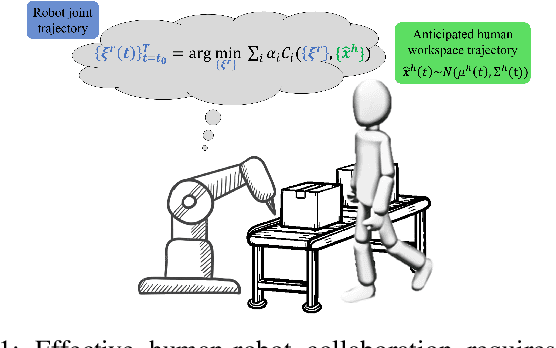
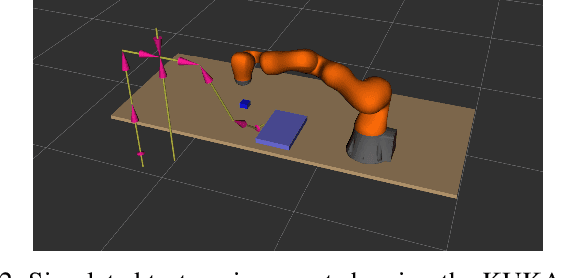
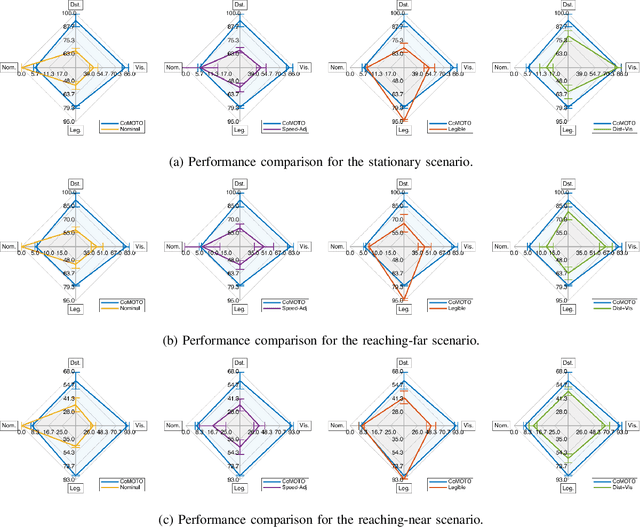
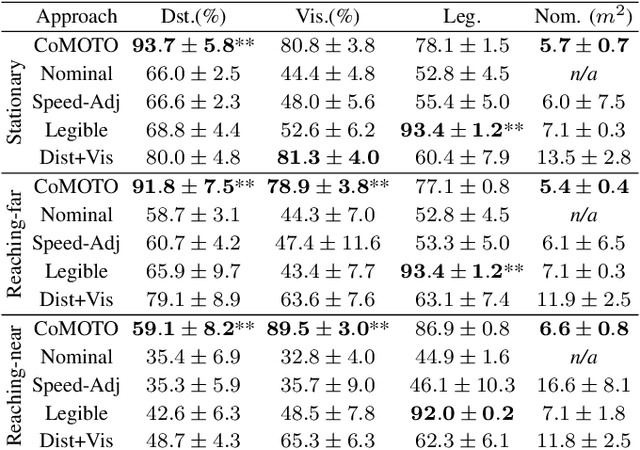
We address the problem of adapting robot trajectories to improve safety, comfort, and efficiency in human-robot collaborative tasks. To this end, we propose CoMOTO, a trajectory optimization framework that utilizes stochastic motion prediction models to anticipate the human's motion and adapt the robot's joint trajectory accordingly. We design a multi-objective cost function that simultaneously optimizes for i) separation distance, ii) visibility of the end-effector, iii) legibility, iv) efficiency, and v) smoothness. We evaluate CoMOTO against three existing methods for robot trajectory generation when in close proximity to humans. Our experimental results indicate that our approach consistently outperforms existing methods over a combined set of safety, comfort, and efficiency metrics.
Human-Centric Active Perception for Autonomous Observation
May 29, 2020David Kent, Sonia Chernova
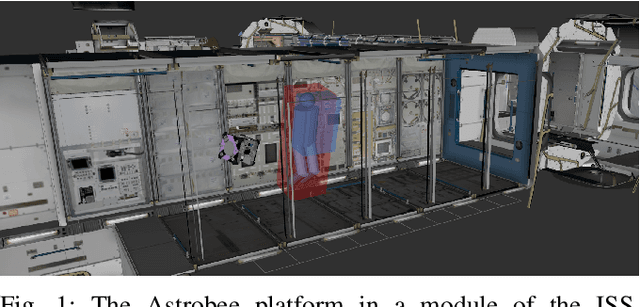
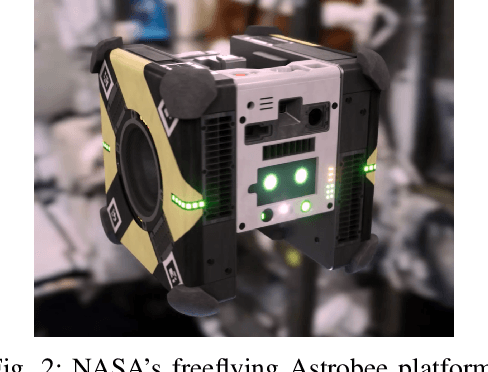
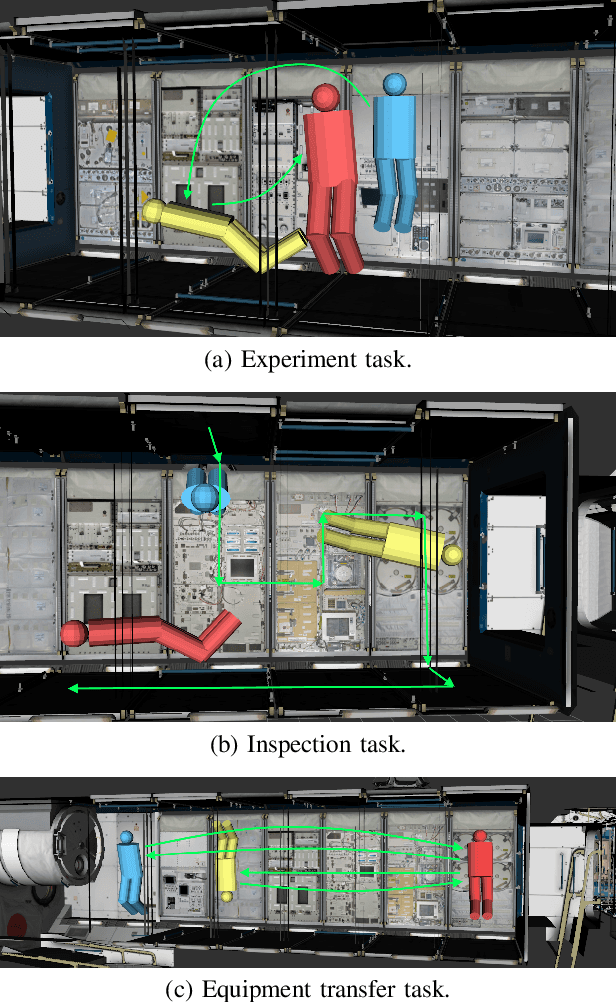
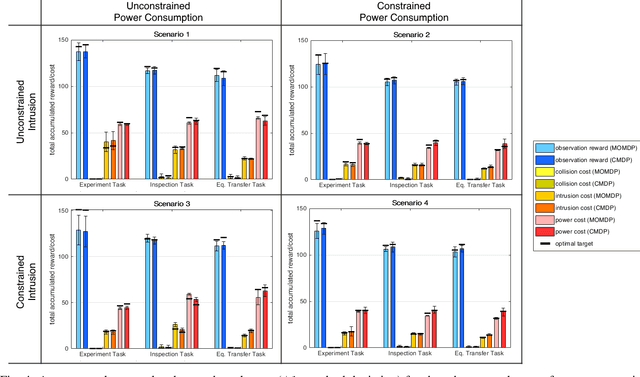
As robot autonomy improves, robots are increasingly being considered in the role of autonomous observation systems -- free-flying cameras capable of actively tracking human activity within some predefined area of interest. In this work, we formulate the autonomous observation problem through multi-objective optimization, presenting a novel Semi-MDP formulation of the autonomous human observation problem that maximizes observation rewards while accounting for both human- and robot-centric costs. We demonstrate that the problem can be solved with both scalarization-based Multi-Objective MDP methods and Constrained MDP methods, and discuss the relative benefits of each approach. We validate our work on activity tracking using a NASA Astrobee robot operating within a simulated International Space Station environment.
Multimodal Material Classification for Robots using Spectroscopy and High Resolution Texture Imaging
Apr 02, 2020Zackory Erickson, Eliot Xing, Bharat Srirangam, Sonia Chernova, Charles C. Kemp
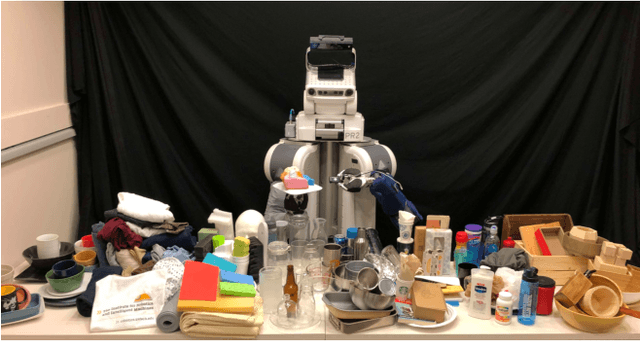

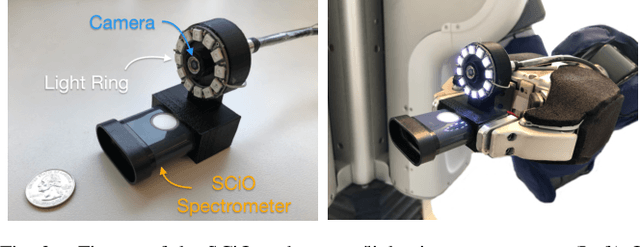
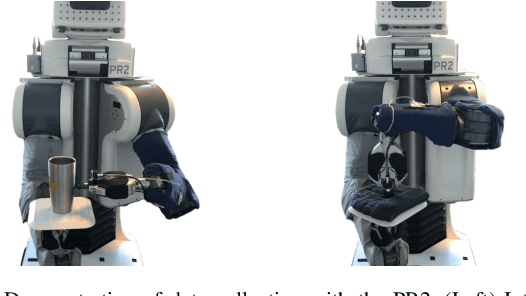
Material recognition can help inform robots about how to properly interact with and manipulate real-world objects. In this paper, we present a multimodal sensing technique, leveraging near-infrared spectroscopy and close-range high resolution texture imaging, that enables robots to estimate the materials of household objects. We release a dataset of high resolution texture images and spectral measurements collected from a mobile manipulator that interacted with 144 household objects. We then present a neural network architecture that learns a compact multimodal representation of spectral measurements and texture images. When generalizing material classification to new objects, we show that this multimodal representation enables a robot to recognize materials with greater performance as compared to prior state-of-the-art approaches. Finally, we present how a robot can combine this high resolution local sensing with images from the robot's head-mounted camera to achieve accurate material classification over a scene of objects on a table.
Leveraging Rationales to Improve Human Task Performance
Feb 11, 2020Devleena Das, Sonia Chernova
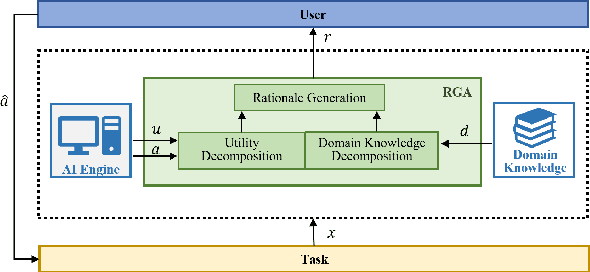
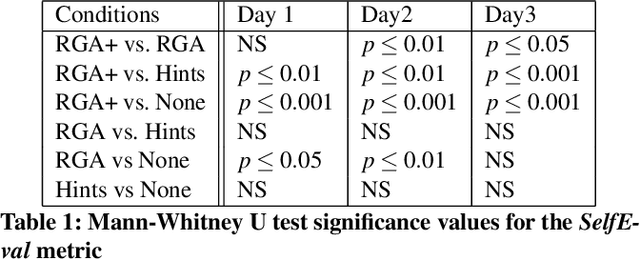
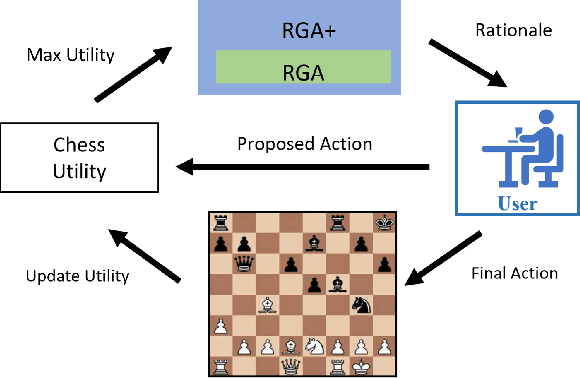

Machine learning (ML) systems across many application areas are increasingly demonstrating performance that is beyond that of humans. In response to the proliferation of such models, the field of Explainable AI (XAI) has sought to develop techniques that enhance the transparency and interpretability of machine learning methods. In this work, we consider a question not previously explored within the XAI and ML communities: Given a computational system whose performance exceeds that of its human user, can explainable AI capabilities be leveraged to improve the performance of the human? We study this question in the context of the game of Chess, for which computational game engines that surpass the performance of the average player are widely available. We introduce the Rationale-Generating Algorithm, an automated technique for generating rationales for utility-based computational methods, which we evaluate with a multi-day user study against two baselines. The results show that our approach produces rationales that lead to statistically significant improvement in human task performance, demonstrating that rationales automatically generated from an AI's internal task model can be used not only to explain what the system is doing, but also to instruct the user and ultimately improve their task performance.
Taking Recoveries to Task: Recovery-Driven Development for Recipe-based Robot Tasks
Jan 28, 2020Siddhartha Banerjee, Angel Daruna, David Kent, Weiyu Liu, Jonathan Balloch, Abhinav Jain, Akshay Krishnan, Muhammad Asif Rana, Harish Ravichandar, Binit Shah, Nithin Shrivatsav, Sonia Chernova
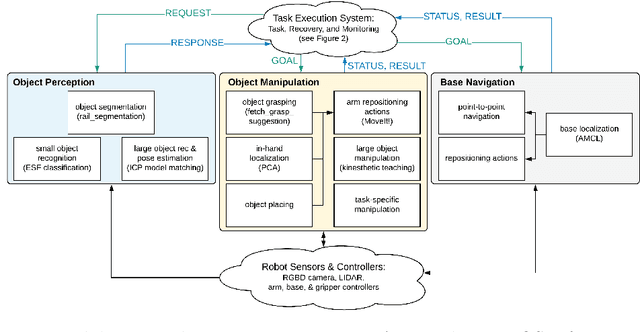
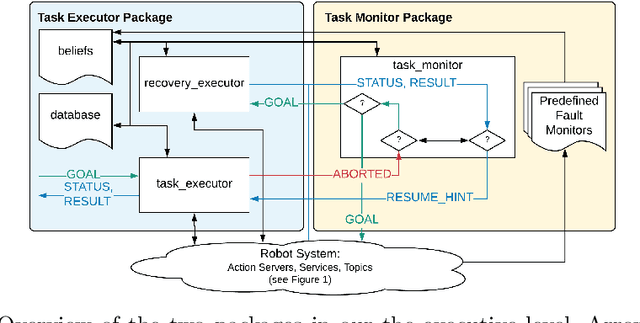


Robot task execution when situated in real-world environments is fragile. As such, robot architectures must rely on robust error recovery, adding non-trivial complexity to highly-complex robot systems. To handle this complexity in development, we introduce Recovery-Driven Development (RDD), an iterative task scripting process that facilitates rapid task and recovery development by leveraging hierarchical specification, separation of nominal task and recovery development, and situated testing. We validate our approach with our challenge-winning mobile manipulator software architecture developed using RDD for the FetchIt! Challenge at the IEEE 2019 International Conference on Robotics and Automation. We attribute the success of our system to the level of robustness achieved using RDD, and conclude with lessons learned for developing such systems.
Are We Making Real Progress in Simulated Environments? Measuring the Sim2Real Gap in Embodied Visual Navigation
Dec 13, 2019Abhishek Kadian, Joanne Truong, Aaron Gokaslan, Alexander Clegg, Erik Wijmans, Stefan Lee, Manolis Savva, Sonia Chernova, Dhruv Batra
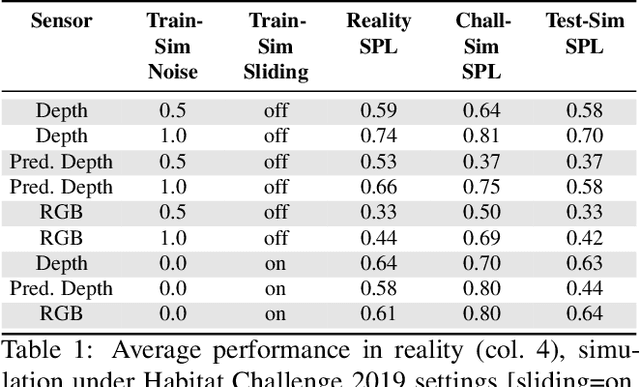
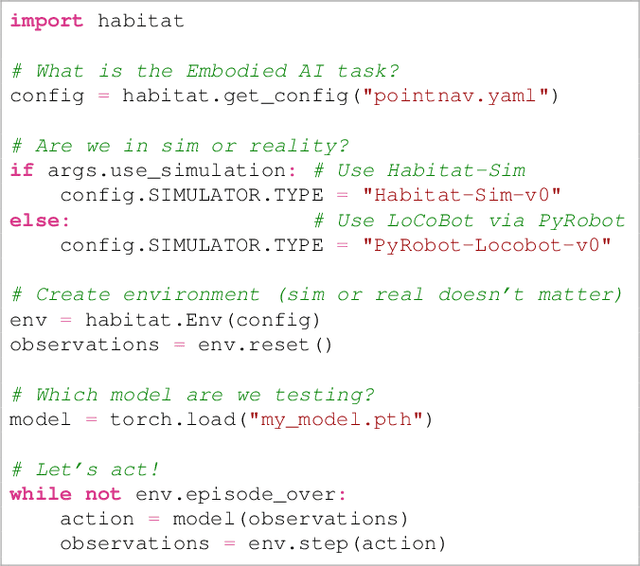
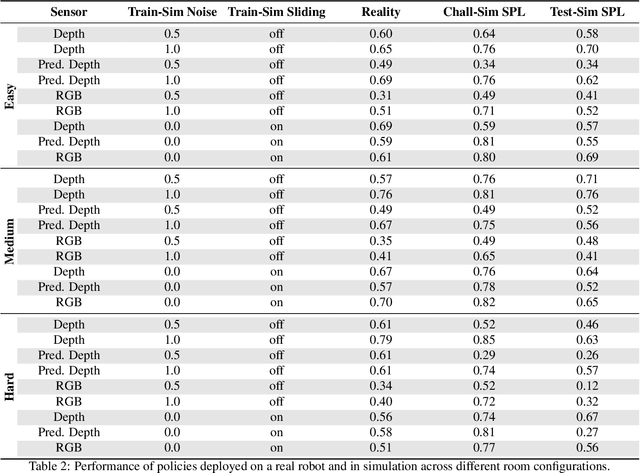

Does progress in simulation translate to progress in robotics? Specifically, if method A outperforms method B in simulation, how likely is the trend to hold in reality on a robot? We examine this question for embodied (PointGoal) navigation, developing engineering tools and a research paradigm for evaluating a simulator by its sim2real predictivity, revealing surprising findings about prior work. First, we develop Habitat-PyRobot Bridge (HaPy), a library for seamless execution of identical code on a simulated agent and a physical robot. Habitat-to-Locobot transfer with HaPy involves just one line change in config, essentially treating reality as just another simulator! Second, we investigate sim2real predictivity of Habitat-Sim for PointGoal navigation. We 3D-scan a physical lab space to create a virtualized replica, and run parallel tests of 9 different models in reality and simulation. We present a new metric called Sim-vs-Real Correlation Coefficient (SRCC) to quantify sim2real predictivity. Our analysis reveals several important findings. We find that SRCC for Habitat as used for the CVPR19 challenge is low (0.18 for the success metric), which suggests that performance improvements for this simulator-based challenge would not transfer well to a physical robot. We find that this gap is largely due to AI agents learning to 'cheat' by exploiting simulator imperfections: specifically, the way Habitat allows for 'sliding' along walls on collision. Essentially, the virtual robot is capable of cutting corners, leading to unrealistic shortcuts through non-navigable spaces. Naturally, such exploits do not work in the real world where the robot stops on contact with walls. Our experiments show that it is possible to optimize simulation parameters to enable robots trained in imperfect simulators to generalize learned skills to reality (e.g. improving $SRCC_{Succ}$ from 0.18 to 0.844).
Tool Substitution with Shape and Material Reasoning Using Dual Neural Networks
Nov 11, 2019Nithin Shrivatsav, Lakshmi Nair, Sonia Chernova
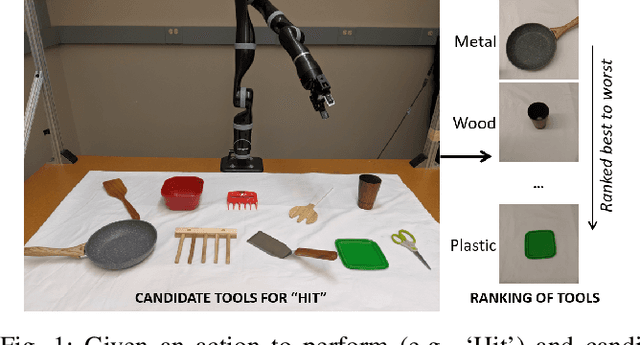
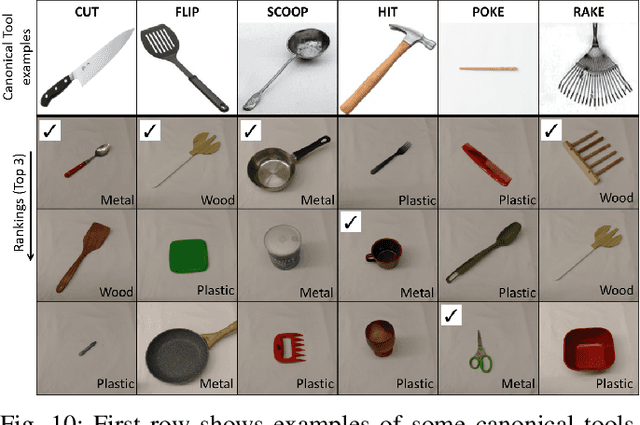
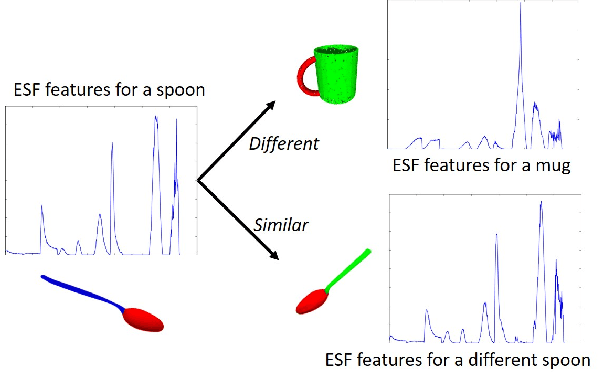
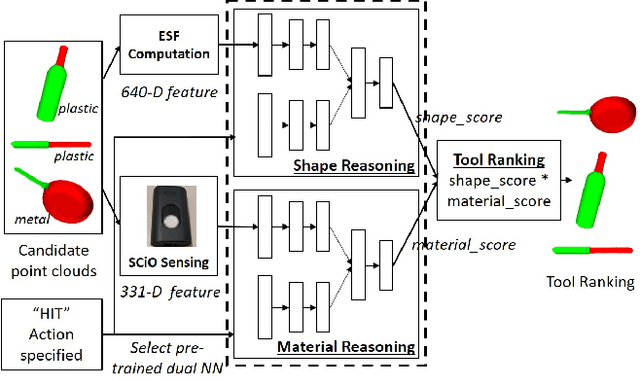
This paper explores the problem of tool substitution, namely, identifying substitute tools for performing a task from a given set of candidate tools. We introduce a novel approach to tool substitution, that unlike prior work in the area, combines both shape and material reasoning to effectively identify substitute tools. Our approach combines the use of visual and spectral reasoning using dual neural networks. It takes as input, the desired action to be performed, and outputs a ranking of the available candidate tools based on their suitability for performing the action. Our results on a test set of 30 real-world objects show that our approach is able to effectively match shape and material similarities, with improved tool substitution performance when combining both.
Benchmark for Skill Learning from Demonstration: Impact of User Experience, Task Complexity, and Start Configuration on Performance
Nov 07, 2019M. Asif Rana, Daphne Chen, S. Reza Ahmadzadeh, Jacob Williams, Vivian Chu, Sonia Chernova
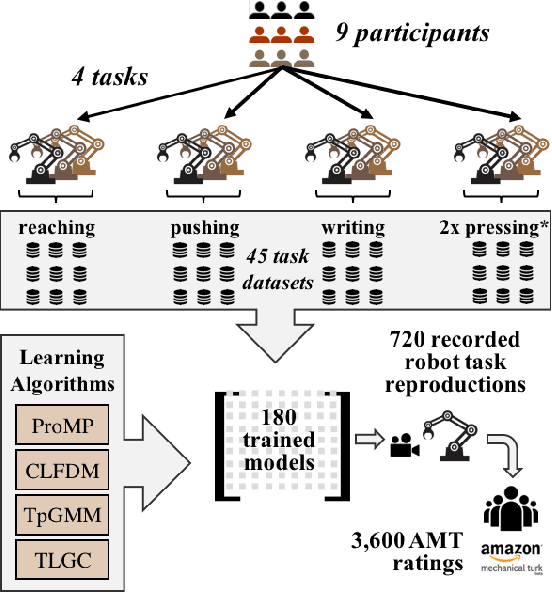
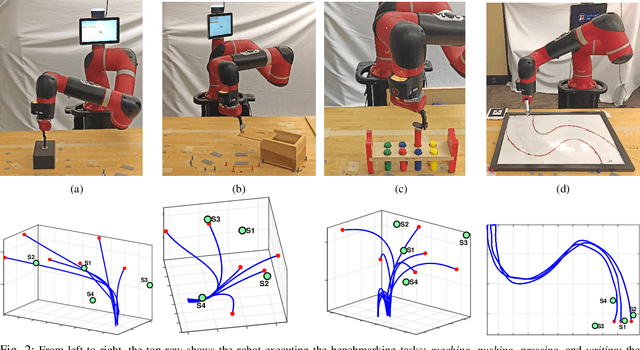
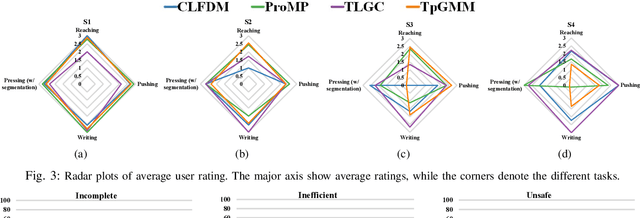

In this work, we contribute a large-scale study benchmarking the performance of multiple motion-based learning from demonstration approaches. Given the number and diversity of existing methods, it is critical that comprehensive empirical studies be performed comparing the relative strengths of these learning techniques. In particular, we evaluate four different approaches based on properties an end user may desire for real-world tasks. To perform this evaluation, we collected data from nine participants, across four different manipulation tasks with varying starting conditions. The resulting demonstrations were used to train 180 task models and evaluated on 720 task reproductions on a physical robot. Our results detail how i) complexity of the task, ii) the expertise of the human demonstrator, and iii) the starting configuration of the robot affect task performance. The collected dataset of demonstrations, robot executions, and evaluations are being made publicly available. Research insights and guidelines are also provided to guide future research and deployment choices about these approaches.
CAGE: Context-Aware Grasping Engine
Sep 24, 2019Weiyu Liu, Angel Daruna, Sonia Chernova
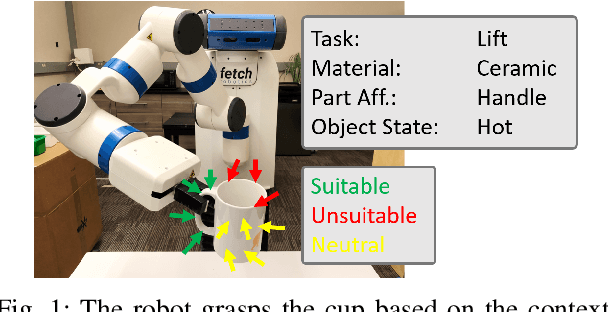
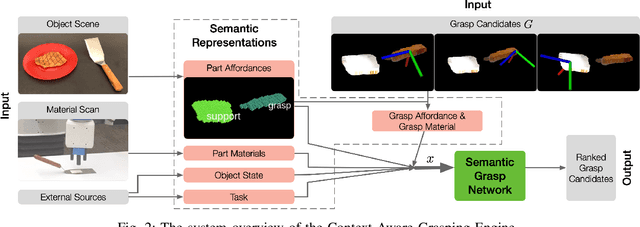
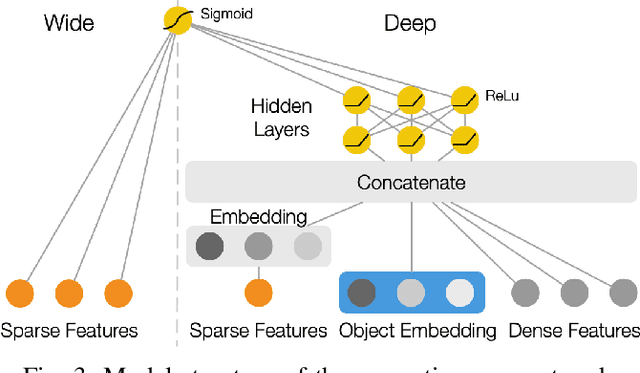
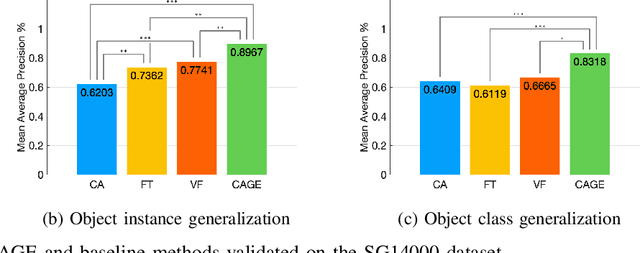
Semantic grasping is the problem of selecting stable grasps that are functionally suitable for specific object manipulation tasks. In order for robots to effectively perform object manipulation, a broad sense of context, including object and task constraints, needs to be accounted for. We introduce the Context-Aware Grasping Engine, a neural network structure based on the Wide & Deep model, to learn suitable semantic grasps from data. We quantitatively validate our approach against three prior methods on a novel dataset consisting of 14,000 semantic grasps for 44 objects, 7 tasks, and 6 different object states. Our approach outperformed all baselines by statistically significant margins, producing new insights into the importance of balancing memorization and generalization of contexts for semantic grasping. We further demonstrate the effectiveness of our approach on robot experiments in which the presented model successfully achieved 31 of 32 grasps.
Active Learning within Constrained Environments through Imitation of an Expert Questioner
Jul 01, 2019Kalesha Bullard, Yannick Schroecker, Sonia Chernova
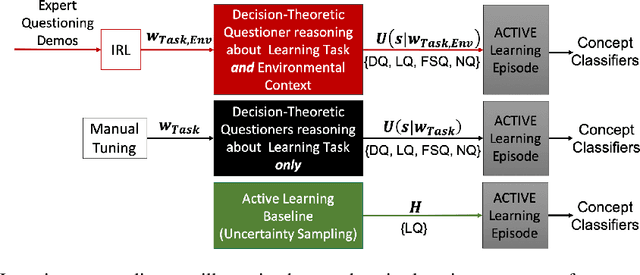
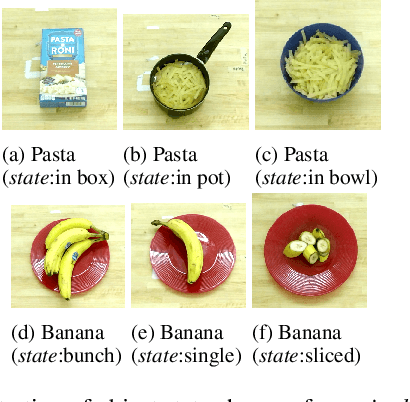
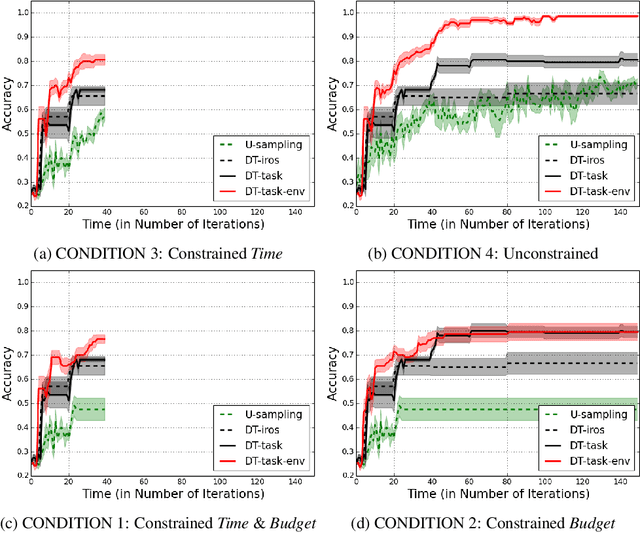
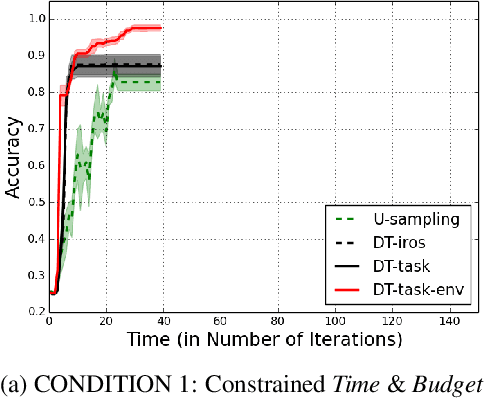
Active learning agents typically employ a query selection algorithm which solely considers the agent's learning objectives. However, this may be insufficient in more realistic human domains. This work uses imitation learning to enable an agent in a constrained environment to concurrently reason about both its internal learning goals and environmental constraints externally imposed, all within its objective function. Experiments are conducted on a concept learning task to test generalization of the proposed algorithm to different environmental conditions and analyze how time and resource constraints impact efficacy of solving the learning problem. Our findings show the environmentally-aware learning agent is able to statistically outperform all other active learners explored under most of the constrained conditions. A key implication is adaptation for active learning agents to more realistic human environments, where constraints are often externally imposed on the learner.
 Add to Chrome
Add to Chrome Add to Firefox
Add to Firefox Add to Edge
Add to Edge